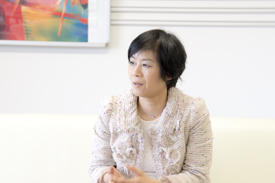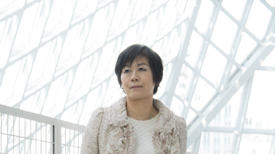

05/26/2014
Two years ago, the AIMR welcomed mathematician Motoko Kotani as its new director. Since then, the institute has established itself globally through its innovative focus on mathematics-flavored materials science research. AIMResearch spoke to Kotani about her successes in extending the AIMR’s overseas reach through strong research partnerships and creating an international work culture.

AIMResearch: The AIMR continues to develop its international network through joint research centers, partner institutions and inter-faculty exchange agreements. What have these various forms of cooperation achieved?
After taking on the directorship, I introduced a program of joint research centers where postdoctoral researchers can conduct collaborative research. Of the 15 international institutes with which the AIMR has already established agreements, we have built closer relationships through three of the joint research centers in particular: the University of Cambridge in the UK, the University of California, Santa Barbara (UCSB) in the US, and the Institute of Chemistry, Chinese Academy of Sciences. These centers have significantly contributed to our global visibility through the publication of research and co-organizing workshops that bring recognition to the researchers involved as much as the institutes they represent.
AIMResearch: What plans do you have to extend such partnerships in the coming years?
In 2014, we will organize a workshop with the Australian National University and a Tohoku Forum at the University of Cambridge, which will integrate research from the AIMR and our host institute, Tohoku University.
Since we are not a very large institute, our emphasis is on enhancing — as opposed to expanding — our global network. One way that we strengthen the depth of our collaborations is by setting common research agendas with our partners that create a bridge for the two-way exchange of information and researchers.
We are establishing a new joint research center at the University of Chicago in the US and are in discussion with the Chinese Academy of Sciences to create another laboratory in Beijing, together with Tsinghua University. We would also like to extend our relationship with Fraunhofer-Gesellschaft beyond current agreements with three of the organization’s institutes. I would like the AIMR to move toward more joint research through shared grants that can be divided between two countries, for example.
AIMResearch: The AIMR is recognized for cultivating a fertile environment for the free exchange of ideas and every year attracts more of the brightest minds from all over the globe. How have you managed to create such an open and inclusive research atmosphere?
Creating a favorable environment for research is crucial to science. Many researchers are interested in coming to Japan because of its reputation for high-quality research but are deterred by the language barrier. Here at the AIMR, the working language is English. The highly motivated staff at our administrative office help foreign researchers to transition to and settle in Japan, and provide them with essential information and support services for maneuvering the grant application system. In addition, we have initiated a scheme of jointly appointing academics with external partner universities, which affords researchers increasing flexibility and mobility.
Furthermore, I offer many incentives to active researchers. Here at the AIMR, successful researchers receive merit-based benefits like more research space or a salary increase. This attracts very ambitious individuals — the kind of researchers I want at the AIMR.

AIMResearch: According to the latest WPI program review, the AIMR has made “remarkable progress” since introducing a new mathematics–materials approach to research in 2012. How were you able to achieve so much so quickly?
Since the establishment of the AIMR, our researchers have been making commendable progress in taking their research to the next level. Creating a new vision for the AIMR through our mathematics–materials approach allowed us to amalgamate their collective achievements and to direct our resources and research power toward a common goal, thereby multiplying the strengths of the institute. Materials science is a very complex and wide-ranging research area, which makes it impossible to be recognized worldwide across all areas of the field. Therefore, we decided to focus on a few target projects that fit within the mathematics–materials framework. We have identified problems to be studied that are challenging — but also very attractive — from the viewpoints of both mathematics and materials science.
AIMResearch: 2014 marks the eighth year of a ten-year funding commitment to the AIMR from the WPI program. What plans do you have to ensure the long-term future of the institute?
I have met several times with Susumu Satomi, president of Tohoku University, to highlight the AIMR’s contributions to Tohoku University. Despite the AIMR’s small number of principal investigators, half of whom are from abroad, we bring in 5–6 per cent of the external research funds generated by the university. I think that this is remarkable.
Convinced by the AIMR’s significant contribution to system reforms at Tohoku University, the president formally committed the university to establishing a new permanent framework that focuses on globalized, interdisciplinary research across several areas, including mathematics and materials science. The organization will be established in a few months.
The long-term sustainability of the AIMR is very important, especially for young researchers who have only just set out in our new direction. They are doing very good work and it is my responsibility to help them to continue with their research — and what better place than here at the AIMR?